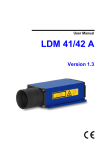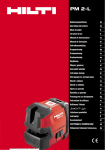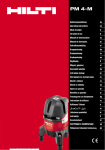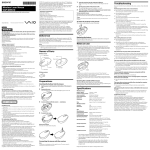Download Hilti 2047044 Use and Care Manual
Transcript
PM 2-L Bedienungsanleitungde Operating instructions en Istruzioni d’uso it Mode d’emploi Manual de instrucciones Manual de instruções fr es pt Gebruiksaanwijzingnl Brugsanvisningda Bruksanvisningsv Bruksanvisningno Käyttöohje fi Használati utasítás hu Οδηγιες χρησεως Instrukcja obsługi Инструкция по зксплуатации el pl ru Návod k obsluze cs Upute za uporabu hr Návod na obsluhu Navodila za uporabo Ръководство за обслужване Instrucţiuni de utilizare Kulllanma Talimatı sk sl bg ro tr ar Lietošanas pamācība lv Instrukcijalt Kasutusjuhendet IНСТРУКЦIЯ З ЕКСПЛУАТАЦIЇ uk Пайдалану бойынша басшылықkk 1 1 4 3 2 2 3 4 5 6 7 8 N " # p " # p " E # E % 10 9 d1 d0 d2 d0 3 10m 2 1 7 6 5 11 T1 2.5m 2m Pos. 1 90p T2 2.5m Pos. 2 ORIGINAL OPERATING INSTRUCTIONS PM 2-L line laser It is essential that the operating instructions are read before the tool is operated for the first time. Always keep these operating instructions together with the tool. Ensure that the operating instructions are with the tool when it is given to other persons. 1 These numbers refer to the corresponding illustrations. The illustrations can be found on the fold-out cover pages. Keep these pages open while studying the operating instructions. In these operating instructions, the designation “the tool” always refers to the PM 2-L line laser. Parts, operating controls and indicators 1 @ On/off button with LED ; Slide switch for pendulum locking mechanism = Laser exit window % Battery compartment Contents Page 1. General information 13 2. Description 14 3. Accessories 15 4. Technical data 16 5. Safety instructions 17 6. Before use 18 7. Operation 19 8. Care and maintenance 20 9. Troubleshooting 21 10. Disposal 22 11. Manufacturer’s warranty 22 12. FCC statement (applicable in USA) 23 13. EC declaration of conformity (original) 23 1. General information 1.1 Safety notices and their meaning DANGER Draws attention to imminent danger that will lead to serious bodily injury or fatality. WARNING Draws attention to a potentially dangerous situation that could lead to serious personal injury or fatality. CAUTION Draws attention to a potentially dangerous situation that could lead to slight personal injury or damage to the equipment or other property. NOTE Draws attention to an instruction or other useful information. 1.2 Explanation of the pictograms and other information Warning signs General warning 13 en Symbols On the tool >1/4s en Read the operating instructions before use. Disposal of power tools or appliances and batteries together with household waste is not permissible. On the tool CAUTION LASER RADIATION - DO NOT STARE INTO BEAM 620-690nm/0.95mW max. CLASS II LASER PRODUCT Do not stare into the beam. Laser warning plates for the USA in accordance with CFR 21 § 1040 (FDA). Laser radiation. Do not look into the beam. Laser class 2. Laser warning plate according to IEC60825/EN608251:2007 Location of identification data on the tool The type designation and serial number can be found on the type identification plate on the tool. Make a note of this data in your operating instructions and always refer to it when making an enquiry to your Hilti representative or service department. Type: Generation: 01 Serial no.: 2. Description 2.1 Use of the product as directed The PM 2-L is a self-leveling line laser which allows leveling and alignment work to be carried out quickly and accurately by a single person. The tool projects two laser lines (horizontal and vertical) and a line intersection point. The lines and line intersection point have a range of approx. 10 m. Range depends on the brightness of ambient light. The tool is designed for mainly indoor use and is no substitute for a rotating laser. When used for outdoor applications, care must be taken to ensure that the general conditions are similar to those encountered indoors. Possible applications are: Leveling power outlets, cable trays, radiators and in other items in installation work. Leveling suspended ceilings. Leveling and aligning doors and windows. Transferring heights. Vertical alignment of pipes. Observe the information printed in the operating instructions concerning operation, care and maintenance. Modification of the tool is not permissible. To avoid the risk of injury, use only genuine Hilti accessories and insert tools. The tool and its ancillary equipment may present hazards when used incorrectly by untrained personnel or when used not as directed. 2.2 Features The PM 2-L levels itself automatically within a range of approx. 4°. Self-leveling takes only approx. 3 seconds. When the self-leveling range is exceeded, the laser beams blink to warn the user. The PM 2-L is characterized by its ease of operation and use, its rugged plastic casing and ease of transport due to its compact dimensions and light weight. 14 The tool can be used together with the PMA 31 laser receiver. In the normal operating mode, the tool switches itself off after 1 hour. Sustained operating mode can be activated by pressing and holding the on/off button for four seconds. 2.3 Items supplied with the cardboard box version 1 1 4 1 1 Line laser Soft pouch Batteries Operating instructions Manufacturer’s certificate en 2.4 Information displayed during operation LED The LED does not light. The LED does not light. The LED does not light. The LED lights constantly. The LED blinks twice every 10 seconds (pendulum not locked) or every 2 seconds (pendulum locked). The LED blinks. Laser beam The laser beam blinks twice every 10 seconds (pendulum not locked) or every 2 seconds (pendulum locked). The laser beam blinks five times and then remains permanently on. The laser beam blinks rapidly. The laser beam blinks every 2 seconds. The tool is switched off. The batteries are exhausted. The batteries are inserted incorrectly. The laser beam is switched on. The tool is in operation. The batteries are almost exhausted. The tool is switched off but the pendulum is not locked. The batteries are almost exhausted. Automatic power-off has been deactivated. The tool is unable to level itself (Outside the self-leveling range). Inclined line operating mode. The pendulum is locked, as a result of which the lines are not leveled. 3. Accessories Designation Short designation Tripod Target plate Target plate Laser receiver Telescopic brace PMA 20 PMA 54/55 PRA 50/51 PMA 31 PUA 10 Description 15 Designation Short designation Universal adapter Laser visibility glasses PMA 78 PUA 60 en Description The laser visibility glasses are not protective glasses and thus do not protect the eyes from laser beams. As the laser visibility glasses restrict color vision, they should be worn only when working with the PM 2-L laser tool. Do not wear the laser visibility glasses while driving a vehicle on a public road. 4. Technical data Right of technical changes reserved. Range of the lines and intersection point Level of accuracy setting at room temperature +24 °C (75 °F) 1 Self-leveling time Laser class Line width Self-leveling range Automatic power-off Operating status indicator Power supply Battery life Operating temperature Storage temperature Dust and water spray protection (except battery compartment) Tripod thread (tool) Weight Dimensions without laser receiver: 10 m (33 ft) with laser receiver: 30 m (98 ft) ±3.0 mm at 10 m (±¹/₈ in at 33 ft) 3 s (typical) Class 2, visible, 620 - 690 nm, ±10 nm (EN 608251:2007 / IEC 60825 - 1:2007); class II (CFR 21 §1040 (FDA) Distance 5 m: < 2.2 mm ±4° (typical) Activated after: 1 h LED and laser beams AA‑size batteries, Alkaline batteries: 4 Alkaline battery 2,500 mAh, Temperature +24°C (+75 °F): 14 h (typical) Min. -10°C / Max. +50°C (+14 to 122 °F) Min. -25°C / Max. +63°C (-13 to 145 °F) IP 54 as per IEC 529 UNC¹⁄₄" Without batteries: 0.43 kg (0.95 lbs) 65 x 107 x 95 mm (2 ¹/₂ x 4 ¹/₄ x 3 ³/₄ in) 1 Influences such as, in particular, high temperatures, moisture, shock, fall, etc. may lead to deviations from the level of accuracy which was set. 16 5. Safety instructions WARNING: Ensure that you read all safety precautions and instructions.Failure to observe the safety precautions and instructions may result in electric shock, fire and/or serious injury.Retain all safety precautions and instructions for future reference. 5.1 General safety measures a) Check the accuracy of the tool before using it to take measurements. b) The tool and its ancillary equipment may present hazards when used incorrectly by untrained personnel or when used not as directed. c) To avoid the risk of injury, use only genuine Hilti accessories and additional equipment. d) Stay alert, watch what you are doing and use common sense when operating the machine. Don’t use the machine when you are tired or under the influence of drugs, alcohol or medication. A moment of inattention while operating machines may result in serious personal injury. e) Modification of the tool is not permissible. f) Observe the information printed in the operating instructions concerning operation, care and maintenance. g) Do not render safety devices ineffective and do not remove information and warning notices. h) Keep children and other persons away from the area while the tool or appliance is in use. i) Take the influences of the surrounding area into account. Do not expose the tool to rain or snow and do not use it in damp or wet conditions. Do not use the tool where there is a risk of fire or explosion. j) Maintain the machine carefully. Check for misalignment or binding of moving parts, breakage of parts and any other condition that may affect the machine’s operation. If damaged, have the machine repaired before use. Poor maintenance is the cause of many accidents. k) Have your power tool serviced by a qualified repair person using only identical replacement parts. This will ensure that the safety of the power tool is maintained. l) The user must check the accuracy of the tool after it has been dropped or subjected to other mechanical stresses. m) When the tool is brought into a warm environment from very cold conditions, or vice-versa, allow it to become acclimatized before use. n) Make sure that the tool is mounted securely when adapters or accessories are used. o) Keep the laser exit aperture clean to avoid measurement errors. p) Although the tool is designed for the tough conditions of jobsite use, as with other optical and electronic instruments (e.g. binoculars, spectacles, cameras) it should be treated with care. q) Although the tool is protected to prevent entry of dampness, it should be wiped dry each time before being put away in its transport container. r) Check the accuracy of the measurements several times during use of the tool. 5.2 Proper organization of the workplace a) Secure the area in which you are working and take care to avoid directing the beam towards other persons or towards yourself when setting up the tool. b) Avoid unfavorable body positions when working from ladders. Make sure you work from a safe stance and stay in balance at all times. c) Measurements taken through panes of glass or other objects may be inaccurate. d) Ensure that the tool is set up on a steady, level surface (not subject to vibration). e) Use the tool only within its specified limits. f) If several laser tools are used in the same working area, care must be taken to avoid confusing the beams. g) Magnetic fields may affect the accuracy of the tool. It must thus be kept away from magnetic objects. The tool is not affected by the Hilti universal adapter. h) When working with the receiver, it must be held exactly at right angles to the laser beam. i) Do not use the tool in the proximity of medical instruments. 5.3 Electromagnetic compatibility Although the tool complies with the strict requirements of the applicable directives, Hilti cannot entirely rule out the possibility of the tool being subject 17 en en to interference caused by powerful electromagnetic radiation, leading to incorrect operation. Check the accuracy of the tool by taking measurements by other means when working under such conditions or if you are unsure. Likewise, Hilti cannot rule out the possibility of interference with other devices (e.g. aircraft navigation equipment). 5.4 Laser classification for laser class 2/class II tools Depending on the version purchased, the tool complies with Laser Class 2 in accordance with IEC8251:2007 / EN60825-1:2007 and Class II in accordance with CFR 21 § 1040 (FDA). This tool may be used without need for further protective measures. The eyelid closure reflex protects the eyes when a person looks into the beam unintentionally for a brief moment. This eyelid closure reflex, however, may be negatively affected by medicines, alcohol or drugs. Nevertheless, as with the sun, one should not look directly into sources of bright light. Do not direct the laser beam toward persons. 5.5 Electrical b) To avoid pollution of the environment, the tool must be disposed of in accordance with the currently applicable national regulations. Consult the manufacturer if you are unsure of how to proceed. c) Keep the batteries out of reach of children. d) Do not allow the batteries to overheat and do not expose them to fire. The batteries may explode or release toxic substances. e) Do not charge the batteries. f) Do not solder the batteries into the tool. g) Do not discharge the batteries by short circuiting as this may cause them to overheat and present a risk of personal injury (burns). h) Do not attempt to open the batteries and do not subject them to excessive mechanical stress. i) Do not use damaged batteries. j) Do not mix old and new batteries. Do not mix batteries of different makes or types. 5.6 Liquids Under abusive conditions, liquid may leak from the battery. Avoid contact. If contact accidentally occurs, flush with water. In the event of the liquid coming into contact with the eyes, rinse the eyes with plenty of water and consult a doctor. Liquid ejected from the battery may cause irritation or burns. a) Insulate or remove the batteries before shipping the tool. 6. Before use 1. 2. 6.1 Inserting the batteries 2 DANGER Use only new batteries. 18 3. 4. Open the battery compartment. Remove the batteries from the packaging and insert them in the tool. NOTE Only batteries recommended by Hilti may be used to power the tool. Check that the battery terminals are positioned correctly as shown on the underside of the unit. Close the battery compartment. Check that the catch engages properly. 7. Operation 7.1.5 Using the tool with the PMA 31 laser receiver For further information, please refer to the PMA 31 operating instructions. NOTE To achieve maximum accuracy, project the line onto a vertical, flat surface. When doing so, set up the tool at 90° to the surface. 7.1 Operation 7.1.1 Switching the laser beams on 1. Unlock the pendulum. 2. Press the on/off button once or repeatedly until the desired operating mode is set: NOTE The tool switches between the operating modes according to the sequence shown below and then starts again from the beginning provided that the on/off button is pressed again within 5 seconds each time. Horizontal laser line Vertical laser line Vertical and horizontal laser lines 7.1.2 Switching the tool/laser beams off Press the on/off button until the laser beam is no longer visible and the LED goes out. NOTE - The tool can be switched off if the on/off button has not previously been pressed for at least 5 seconds. - The tool switches itself off automatically after approx. 1 hour. 7.1.3 Deactivating the automatic power-off feature Press and hold the on/off button for approx. 4 sec. until the laser beam blinks five times as confirmation. NOTE The tool will be switched off when the on/off button is pressed or when the batteries are exhausted. en 7.2 Examples of applications 7.2.1 Transferring heights 3 7.2.2 Aligning suspended ceilings 4 7.2.3 Aligning pipes vertically 5 7.2.4 Aligning radiators 6 7.2.5 Aligning door and window frames 7 7.3 Checking 7.3.1 Checking the leveling of the horizontal laser beam 8 1. Place the tool on an even, level surface approx. 20 cm from the wall (A) with the laser beam directed toward the wall (A). 2. Mark the point of intersection of the laser lines on the wall (A) with a cross (1). 3. Turn the tool through 180° and mark the point of intersection of the laser lines on the opposite wall (B) with a cross (2). 4. Place the tool on an even, level surface approx. 20 cm from the wall (B) with the laser beam directed toward the wall (B). 5. Mark the point of intersection of the laser lines on the wall (B) with a cross (3). 6. Turn the tool through 180° and mark the point of intersection of the laser lines on the opposite wall (A) with a cross (4). 7. Measure the distances d1 between (1) and (4) and d2 between (2) and (3). 7.1.4 Inclined line function Lock the pendulum. The tool does not level itself automatically. The laser beam(s) blink(s) every two seconds. 19 8. en 9. Mark the mid points of d1 and d2. If the reference points 1 and 3 are located on different sides of the mid point, then subtract d2 from d1. If the reference points 1 and 3 are located on the same side of the mid point, then add d1 and d2 together. Divide the result by twice the length of the room (room length x 2). The maximum permissible error is 3 mm. 7.3.2 Checking the accuracy of the horizontal line 9 10 1. Place the tool at the edge of a room with a length of at least 10 m. NOTE The floor surface must be even and level. 2. Switch on all laser beams. 3. Set up a target plate at a distance of at least 10 m from the tool, so that the point of intersection of the laser lines lies in the center of the target plate (d0) and the vertical line on the target plate runs exactly through the middle of the vertical laser line. 4. Pivot the tool clockwise through 45° (as seen from above). 5. Then mark the point (d1) on the target plate where the horizontal laser line strikes the vertical line on the target plate. 6. Pivot the tool counterclockwise through 90°. The reference point must remain on the center of the reference cross. 7. Then mark the point (d2) on the target plate where the horizontal laser line strikes the vertical line on the target plate. 8. Measure the following vertical distances: d0-d1, d0-d2 and d1-d2. NOTE The greatest measured vertical distance must be no more than 5 mm at a working distance of 10 m. 7.3.3 Checking the vertical lines 11 1. Position the tool at a height of 2 meters. 2. Switch the tool on. 3. Position the first target plate T1 (vertical) at a distance of 2.5 meters from the tool at the same height (2 meters), so that the vertical laser beam strikes the plate. Mark this position. 4. Then place the second target plate T2 at a position 2 meters below the first target plate, so that the vertical laser beam strikes the plate. Mark this position. 5. Mark position 2 at the opposite side of the test setup (mirror image) on the laser line on the floor at a distance of 5 meters from the tool. 6. Now place the tool on the floor on the mark for position 2 which you have just made. Direct the laser beam toward the target plates T1 and T2 so that it strikes the plates close to their center lines. 7. Read the distances D1 and D2 from each target plate (distance of the laser line from the center of the target plate) and calculate the difference (D = D1 - D2). NOTE Take care to ensure that the target plates are parallel to each other and that they are in the same vertical plane. (Horizontal alignment may result in measurement error). If the difference D is greater than 3 mm, the tool must be returned to a Hilti repair center for readjustment. 8. Care and maintenance 8.1 Cleaning and drying 1. Blow dust off the glass. 2. Do not touch the glass with the fingers. 3. Use only a clean, soft cloth for cleaning. If necessary, moisten the cloth slightly with pure alcohol or a little water. NOTE Do not use any other liquids as these may damage the plastic components. 20 4. Observe the temperature limits when storing your equipment. This is particularly important in winter / summer if the equipment is kept inside a motor vehicle (-25°C to +60°C). 8.2 Storage Remove the tool from its case if it has become wet. The tool, its carrying case and accessories should be cleaned and dried (at maximum 63°C / 145°F). Repack the equipment only once it has dried completely and then store it in a dry place. Check the accuracy of the equipment before it is used after a long period of storage or transportation. Remove the batteries from the tool before storing it for a long period. Leaking batteries may damage the tool. 8.3 Transport Use the Hilti toolbox or packaging of equivalent quality for transporting or shipping your equipment. CAUTION Always remove the batteries before shipping the tool. 8.4 Hilti calibration service We recommend that the tool is checked by the Hilti calibration service at regular intervals in order to verify its reliability in accordance with standards and legal requirements. Use can be made of the Hilti calibration service at any time, but checking at least once a year is recommended. The calibration service provides confirmation that the tool is in conformance, on the day it is tested, with the specifications given in the operating instructions. The tool will be readjusted if deviations from the manufacturer’s specification are found. After checking and adjustment, a calibration sticker applied to the tool and a calibration certificate provide written verification that the tool operates in accordance with the manufacturer’s specification. Calibration certificates are always required by companies certified according to ISO 900x. Your local Hilti Center or representative will be pleased to provide further information. 9. Troubleshooting Fault Possible cause Remedy The tool cannot be switched on. The battery is exhausted. The battery is inserted the wrong way round (incorrect polarity). The battery compartment is not closed. The tool or the on/off button is faulty. The laser source or laser control unit is faulty. The laser source or laser control unit is faulty. The temperature is too high or too low. The tool is set up on an excessively inclined surface. The tilt sensor is faulty. Replace the battery. Insert the battery correctly. Individual laser beams don’t function. The tool can be switched on but no laser beam is visible. Automatic leveling doesn’t function. Close the battery compartment. If necessary, the power tool should be repaired by Hilti Service. If necessary, have the power tool repaired by Hilti Service. If necessary, have the power tool repaired by Hilti Service. Allow the tool to cool down or warm up. Set up the tool on the level. If necessary, have the power tool repaired by Hilti Service. 21 en 10. Disposal en WARNING Improper disposal of the equipment may have serious consequences: The burning of plastic components generates toxic fumes which may present a health hazard. Batteries may explode if damaged or exposed to very high temperatures, causing poisoning, burns, acid burns or environmental pollution. Careless disposal may permit unauthorized and improper use of the equipment. This may result in serious personal injury, injury to third parties and pollution of the environment. Most of the materials from which Hilti tools or appliances are manufactured can be recycled. The materials must be correctly separated before they can be recycled. In many countries, Hilti has already made arrangements for taking back old tools and appliances for recycling. Ask Hilti Customer Service or your Hilti representative for further information. For EC countries only Disposal of electric appliances together with household waste is not permissible. In observance of European Directive 2002/96/EC on waste electrical and electronic equipment and its implementation in accordance with national law, electric tools that have reached the end of their life must be collected separately and returned to an environmentally compatible recycling facility. Dispose of the batteries in accordance with national regulations. 11. Manufacturer’s warranty Hilti warrants that the tool supplied is free of defects in material and workmanship. This warranty is valid so long as the tool is operated and handled correctly, cleaned and serviced properly and in accordance with the Hilti Operating Instructions, and the technical system is maintained. This means that only original Hilti consumables, components and spare parts may be used in the tool. Additional claims are excluded, unless stringent national rules prohibit such exclusion. In particular, Hilti is not obligated for direct, indirect, incidental or consequential damages, losses or expenses in connection with, or by reason of, the use of, or inability to use the tool for any purpose. Implied warranties of merchantability or fitness for a particular purpose are specifically excluded. This warranty provides the free-of-charge repair or replacement of defective parts only over the entire lifespan of the tool. Parts requiring repair or replacement as a result of normal wear and tear are not covered by this warranty. For repair or replacement, send the tool or related parts immediately upon discovery of the defect to the address of the local Hilti marketing organization provided. This constitutes Hilti’s entire obligation with regard to warranty and supersedes all prior or contemporaneous comments and oral or written agreements concerning warranties. 22 12. FCC statement (applicable in USA) CAUTION This equipment has been tested and found to comply with the limits for a class B digital device, pursuant to part 15 of the FCC rules. These limits are designed to provide reasonable protection against harmful interference in a residential installation. This equipment generates, uses and may radiate radio frequency energy. Accordingly, if not installed and used in accordance with the instructions, it may cause harmful interference to radio communications. reception, which can be determined by turning the equipment on and off, the user is encouraged to try to correct the interference by one or more of the following measures: However, there is no guarantee that interference will not occur in a particular installation. If this equipment does cause harmful interference to radio or television NOTE Changes or modifications not expressly approved by Hilti may restrict the user’s authorization to operate the equipment. en Re-orient or relocate the receiving antenna. Increase the distance between the tool and receiver. Consult your dealer or an experienced TV/radio technician for assistance. 13. EC declaration of conformity (original) Designation: Type: Year of design: Line laser PM 2-L 2012 We declare, on our sole responsibility, that this product complies with the following directives and standards: 2004/108/EC, 2006/95/EC, 2011/65/EU, EN 12100. Technical documentation filed at: Hilti Entwicklungsgesellschaft mbH Zulassung Elektrowerkzeuge Hiltistrasse 6 86916 Kaufering Deutschland Hilti Corporation, Feldkircherstrasse 100, FL‑9494 Schaan Paolo Luccini Head of BA Quality and Process Management Business Area Electric Tools & Accessories 04/2012 Roman Haenggi Head of BU Measuring Systems BU Measuring Systems 04/2012 23 Hilti Corporation 2049117 / A2 2049117 Hilti = registered trademark of Hilti Corp., Schaan W 4209 | 0612 | 00-Pos. 1 | 1 Printed in China © 2012 Right of technical and programme changes reserved S. E. & O. *2049117* LI-9494 Schaan Tel.: +423 / 234 21 11 Fax: +423 / 234 29 65 www.hilti.com





























